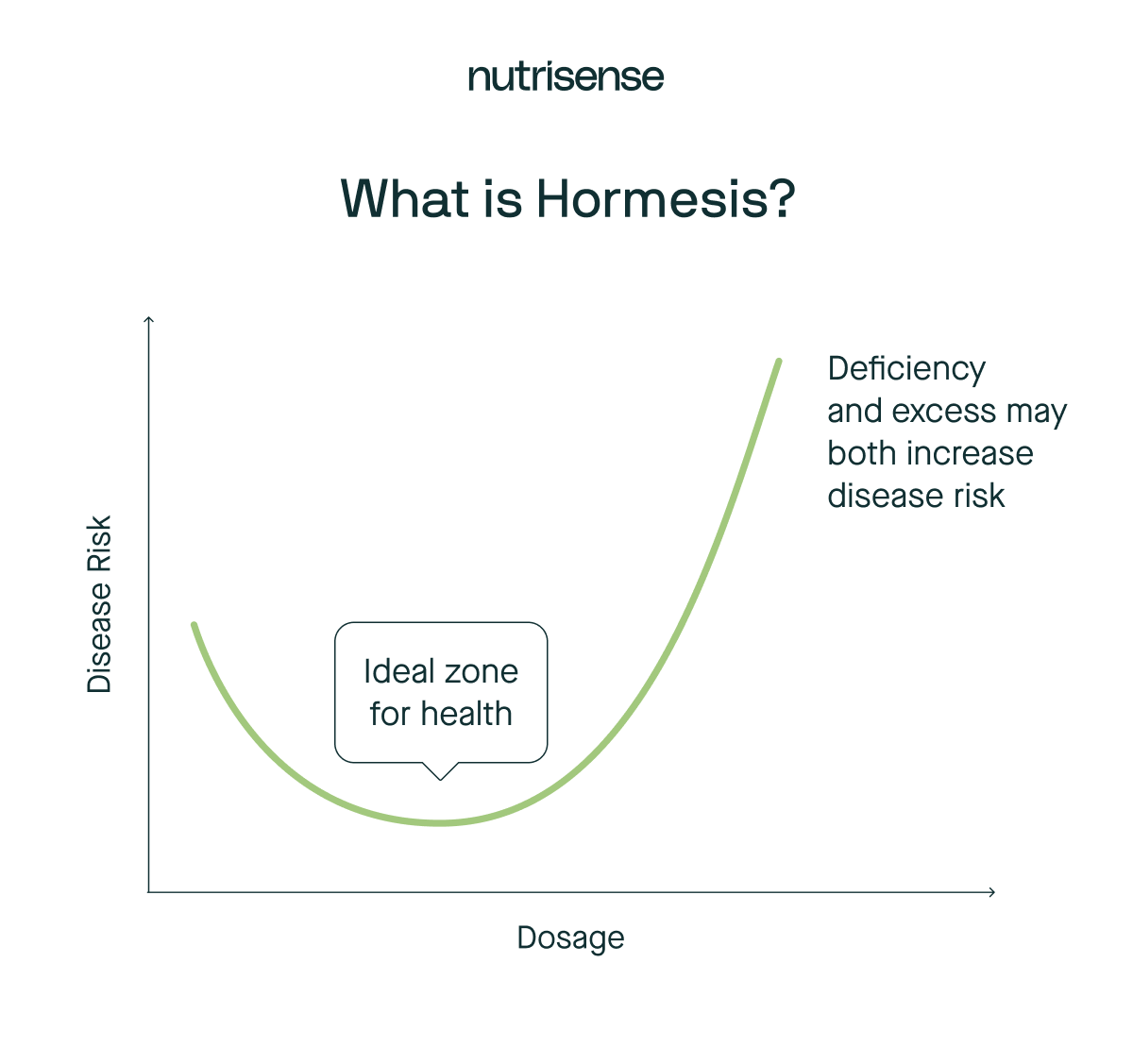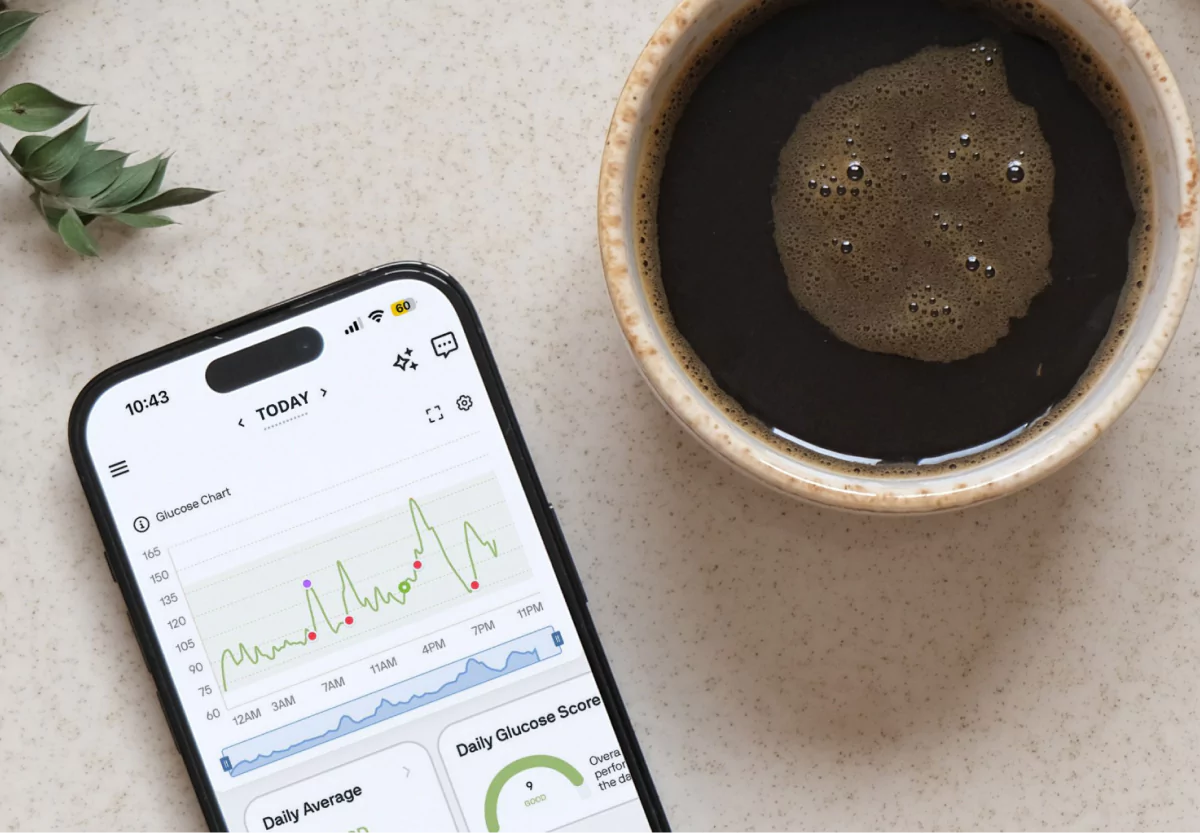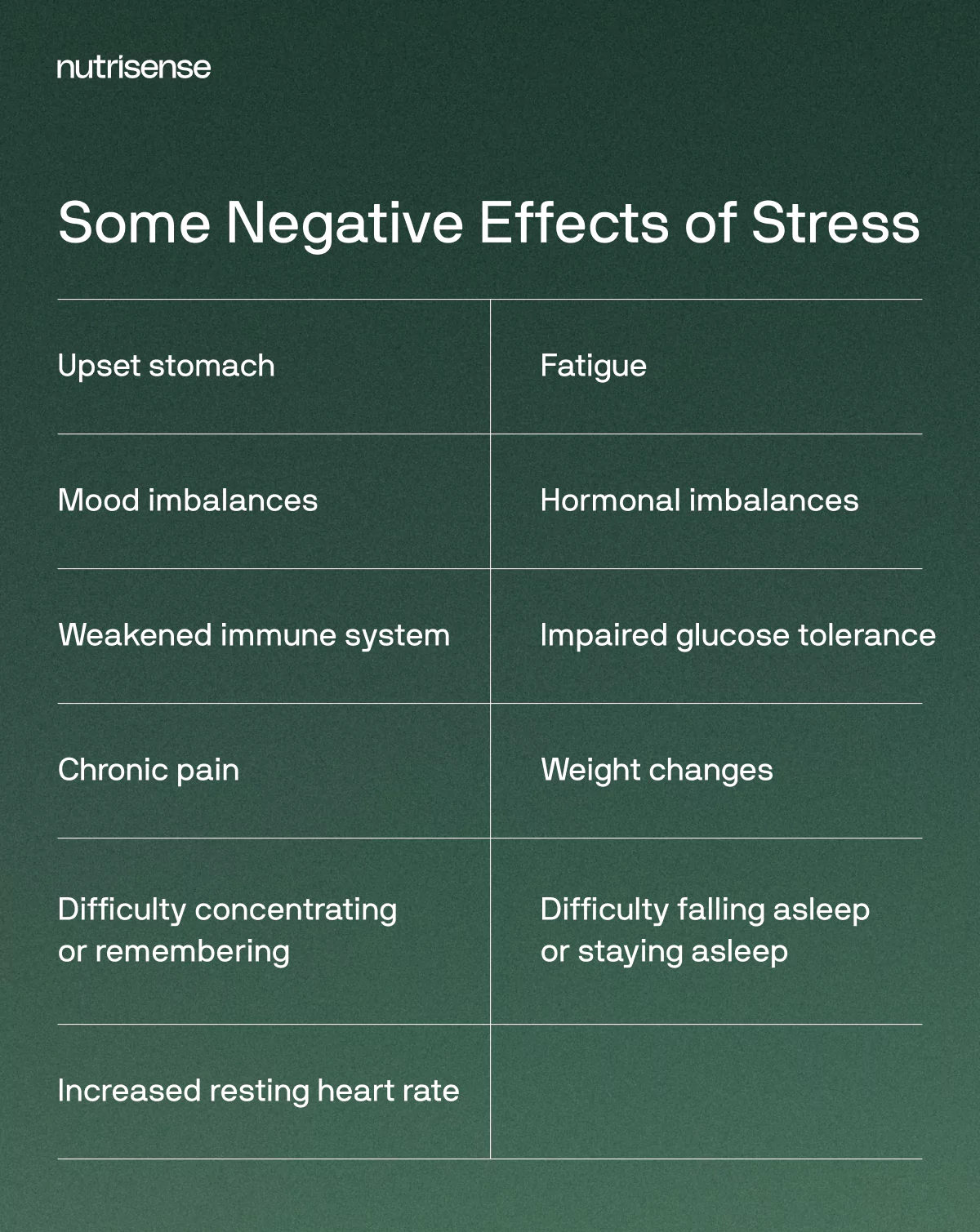Unveiling the Upside of Stress: How Hormetic Stress Boosts Your Well-Being

Key Takeways
Have you ever noticed that a small amount of something might make you feel better but a larger amount of that same thing will make you feel worse? Maybe you feel energized and reinvigorated after a bit of sun, but after longer hours in the heat, you feel drained or even downright sick.
Whether or not you’re aware of it, you experience the phenomenon of hormesis or hormetic stress daily in many different ways. In this article, we’ll explore the fascinating science of hormetic stress, breaking it down in a simple way to help you leverage this concept to support you on your health journey.
What is Hormesis?
Hormesis describes the pattern for how your body responds to stress, no matter where that stress comes from. The concept of hormesis helps explain why the amount of something might be every bit as important as the type of thing itself.
You may have noticed the impact of hormesis with certain foods, fasting, exercise, or even specific substances like alcohol, caffeine or even some herbs or supplements. The right doses of these things can be positive for the body—but overdoing it can lead to negative effects.
Common Types of Stress

There are different types of stress, and not all of them are bad! It all depends on the dose. Severe or mild stress can come from many places, including:
- Nutritional deficiency or excess, including fasting
- Exercise
- Environmental exposures to antigens, pathogens, or xenobiotics
- Extreme temperature changes
- Psychosocial pressures
- Sleep deprivation
- Some medications, supplements or other bioactive compounds
- Alcohol or other substances
In short periods and certain doses, some of these stressors may be helpful or even improve your body’s metabolic health and ability to handle stress. This can be a delicate balance, however, so it’s important to be aware of these stressors.
Understanding Hormetic Stress

Hormesis is known by multiple names, such as:
- Preconditioning
- Conditioning
- Pretreatment
- Cross tolerance
- Adaptive homeostasis
“As a concept, hormesis is pretty simple. It represents the idea of a happy medium or a “sweet spot”, where both too little or too much of something is to be avoided. Your body may respond very differently to something depending on the dose.“
Everywhere you look in nature, you’ll find examples of hormesis. Indeed, hormesis is recognized as a fundamental concept in biology, and affects areas such as toxicology, microbiology, medicine, public health, and even agriculture.
As you can see in the graph above, hormesis appears as a J or U-shaped curve. This pattern is what’s considered a non-linear or biphasic curve, reflecting the dose-response nature of different stressors applied to the body.
Essentially, it helps explain how too much of a good thing is a very real phenomenon! In the trough of the J or U is your optimal dosage for health. Either higher side of the U will represent the dosage that may be damaging for health.
More specifically, this depicts a dose-response relationship to stressors with a low-dose stimulation and high-dose inhibition. This means that relatively lower levels of some stressors are necessary and may improve the capacity of cells and organisms to withstand greater stress, but at higher levels of stress, those same stressors may disrupt the body’s optimal functioning.
Examples of Hormesis

Are you wondering what patterns of hormesis and hormetic stress look like in practice? Dietary restriction, fasting, and cold exposure (like ice baths) are some of the most popular areas explored in today’s hormetic stress models.
But examples of hormesis go far beyond these headliners. Below are some other ways to understand hormesis in your everyday life.
Nutrition
The principle of hormesis dictates a lot about what is helpful or harmful in our dietary approach. What, when, and how you eat are all critical parts of nutrition and metabolic health. Each of these contain examples of hormetic stress.
- What you eat: Nutrients, such as vitamins and minerals, follow the J or U-shaped curve pattern. For example, both too little and too much iodine can cause goiter. Similarly, both too little and too much zinc can impair the immune system. And both too little and too much vitamin C can lead to more oxidative stress.
- When you eat: Intermittent fasting has gained a lot of attention in recent years. But more fasting isn’t always better, even if some lesser amount is beneficial. It’s also true that what might be “just enough” for one person could be “too much” for someone else. Each of us has a unique response to stressors.
- How or how much you eat: How you combine and portion your foods through the day has a sweet spot as well. Certain amounts of protein eaten in a sitting, for example, are needed to stimulate muscle protein synthesis. However, consuming much higher protein loads in one sitting that exceed what your body can sufficiently process may put too much added stress on the body.
Exercise

You may already be familiar with the basic concept of conditioning for the goal of optimizing fitness and performance over time. Low levels of exercise-induced stress can stimulate existing cellular and molecular pathways that improve your body’s capacity to endure higher levels of those same stressors in the future without breaking down. This is hormesis in action.
During exercise, whether it’s high-intensity interval training or going out for a brisk walk, the body is exposed to various forms of stress which can lead to changes in:
- Body temperature
- Oxygen availability, including oxidative stress
- Mechanical pressure on the musculoskeletal system
- Nutrient or fuel transport and utilization
Depending on the dose, these stressors may activate biochemical messengers, which in turn trigger other signaling pathways regulating gene expression and impacting adaptive responses in your body.
Environmental Stress
Your environment has a direct impact on your stress levels and can also shape how your body handles stress. Some examples of environmental stress include:
- Heat exposure, changes in temperature, elevation, and UV or some other types of radiation
- Exposure to xenobiotics or other foreign toxins
- Exposure to antigens from microbial pathogens or other allergens
Sauna and Cold-Water Immersion

You may have heard people like Wim Hof advocating the use of cold-water immersion (CWI) or sauna for optimizing health. The belief is that an ice bath or cold shower may in part activate your body’s stress response in a beneficial way, harnessing the benefits of hormesis.
A 2022 research paper published in the International Journal of Circumpolar Health found that there may indeed be some beneficial impact of CWI on health. However, they felt the question of benefit was only “partly answered”, with much more research needed to solidify the evidence.
At the same time, studies have suggested that regular sauna bathing may improve cellular heat stress tolerance and improve insulin sensitivity for some people. Though it’s important to note here that many of these studies have been done in healthy populations and different outcomes may be seen for those with certain health concerns or conditions.
Glucose and Hormesis

As you may already know, your glucose levels naturally fluctuate through the day. Avoiding spending too much time in the very low ranges (hypoglycemia) and very high ranges (hyperglycemia) can be a healthy goal. Here you can already see how optimal glucose may have its own happy medium.
Another way hormesis plays out in glucose metabolism is through a phenomenon known as glycohormesis. Glycohormesis is a process that some researchers believe helps cells to pre-adapt to rising glucose levels.
When glucose stays elevated for longer periods of time, this environment may lead to higher amounts of reactive oxygen species (ROS) and advanced glycation end products (AGEs) that cause oxidative stress and cellular damage. However, your body has many antioxidant defense mechanisms that help counteract damage from oxidative stress.
Glycohormesis suggests that brief infrequent glucose spikes might actually be helpful for priming these defense mechanisms. So does this mean that a glucose spike may be helpful on some level?
Researchers say it all depends, but it’s possible that brief and infrequent increases in glucose concentration may be beneficial for activating certain cellular protective mechanisms. Just don’t forget that these mechanisms can also be overwhelmed if the increased glucose concentration persists. Less is More: Benefits of Hormetic Stress

“The dose makes the poison”, as they say. As you now know, when it comes to stress, the center of the U-shaped curve is typically where you thrive and feel your best—and that balance may be different for different individuals.
It’s also important to remember that your individual health history and current medical conditions influence a great deal about how your body responds to any and all stressors. When you find that happy middle zone, some of the beneficial effects of hormetic stress may include:
- Strengthening resilience on a cellular level
- Improving physical conditioning
- Activating cellular repair mechanisms
- Regulating hormone production and balance
- Supporting the immune system
There are many complex proposed mechanisms for exactly how your body reaps the benefits of hormetic stress. Many of them take place on the molecular level and have compounded effects that bring about emergent higher level changes in how you feel and function.
Negative Effects of Stress

But what happens if you push the envelope a little too much and end up drifting further into that far side of the U-shaped curve? If you’re feeling worse or struggling to see improvements from where you are at right now, you might need to change things up.
The negative effects of stress have been well documented and may impair many aspects of your body’s function, leading to:
- Fatigue
- Mood imbalances, including more anxiety and depression
- Upset stomach or digestive problems
- Chronic pain or migraines
- Difficulty concentrating or remembering
- Weakened immune system
- Problems managing blood pressure
- Imbalances in hormones that lead to menstrual irregularities, loss of libido, or even impaired fertility
- Impaired glucose tolerance
- Weight changes
- Difficulty falling asleep or staying asleep
- Delayed wound healing
- Increased resting heart rate
It’s a good idea to have the guidance of a qualified medical and nutritional professional when assessing and locating your personal sweet spot in areas of nutrition, activity, and beyond.
Listen to Your Body
One of the most important things to remember when seeking to leverage the benefits of hormetic stress is that individual responses to stressors can vary quite a bit. A certain approach or protocol that works well for one person to improve well-being might backfire and worsen well-being for another.
This is why it’s so important to become familiar with your body’s unique signs and feedback. Don’t ignore or minimize issues such as chronic fatigue or other persistent troubling symptoms.
If you do experience chronic or persistent health concerns, always speak with your doctor.
Find the right Nutrisense programto turn insight into progress.
Go Beyond Glucose Data with Nutrisense
Your glucose can significantly impact how your body feels and functions. That’s why stable levels are an important factor in supporting overall wellbeing. But viewing glucose isn't enough. Nutrisense, you’ll be able to learn how to use your body's data to make informed lifestyle choices that support healthy living.
One-to-one coaching
Sign up to access insurance-covered video calls to work with a glucose expert: a personal registered dietitian or certified nutritionist who will help tailor your lifestyle and diet to your goals.
Monitor and measure what matters
With the Nutrisense CGM Program, you can monitor your glucose with health tech like glucose biosensors and continuous glucose monitor (CGM)s, and analyze the trends over time with the Nutrisense App. This will help you make the most informed choices about the foods you consume and their impact on your health.
Find your best fit
Ready to take the first step? Start with our quiz to find the right Nutrisense program to help you take control.

Jordyn has a bachelor’s degree in biology, a graduate degree in Human Nutrition and completed a dietetic internship at the Memphis VA. She's a dietitian at Nutrisense, and has experience working as a clinical dietitian at a VA medical center specializing in oncology and at the Mayo Clinic, working with a wide range of patients ranging from neonates in the NICU to adult ICU.




